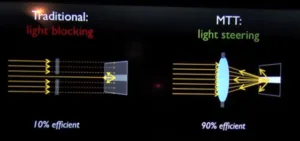With High Dynamic Range (HDR) TVs offering 600 to 1000 cd/m² of peak luminance and various levels of black, many are concerned that the experience in the cinema is starting to lag behind the home experience. IMax and Dolby offer HDR cinematic experiences, but a solution for mainstream theaters is needed, too. But a new approach may be possible – and Barco is the one that plans to nurture the technology via a recent acquisition of MTT Innovations.

 We spoke with MTT Innovations CEO, Anders Ballestad, to get his take on the deal with Barco. “The acquisition was actually initiated by a potential customer we were working with. They believed, and we agreed, that working with a top tier projector maker would be necessary to fully commercialize the technology and would we be willing to talk to Barco about this?”, noted Ballestad. “We had already had some initial discussions with Barco, but agreed that having a customer as part of the conversation would be a more powerful discussion. Talks began last fall and accelerated after the first of the year culminating in a deal by the end of May.”
We spoke with MTT Innovations CEO, Anders Ballestad, to get his take on the deal with Barco. “The acquisition was actually initiated by a potential customer we were working with. They believed, and we agreed, that working with a top tier projector maker would be necessary to fully commercialize the technology and would we be willing to talk to Barco about this?”, noted Ballestad. “We had already had some initial discussions with Barco, but agreed that having a customer as part of the conversation would be a more powerful discussion. Talks began last fall and accelerated after the first of the year culminating in a deal by the end of May.”
Ballestad could not reveal the terms of the deal, but Barco essentially acquired 100% of the shares of MTT Innovations so the seven employees are now Barco personnel. He also could not say anything more on the customer who helped initiate the deal other than to say they are an organization with some industry influence. That could mean a major exhibitor chain or major Hollywood studio, seems to me. Some studios have seen demos of the technology, so this seems like a better bet to me.
In terms of the technology they are developing, again, not much can be revealed now, but based on some previous interview notes, we can get a sense of where the company is going.
MTT Innovations was cofounded by Gerwin Damberg while pursuing his PhD in the Physical Simulation and Measurement lab at the University of British Columbia (UBC). He had previously worked with the co-founder, including Anders Ballestad, at another UBC affiliated startup called Brightside Technologies. Brightside was sold to Dolby Laboratories in 2007, where Ballestad continued to work until forming MTT Innovations in 2012.
The team believes that luminance levels in the cinema need to increase dramatically to get to parity with what the home HDR TV sets can offer. In the cinema, the black level can be quite good but is often limited by the minimal ambient light in the theater and reflections from people, seats, walls, etc. Getting to higher luminance levels is a big challenge since the peak luminance in conventional cinemas today is around 50 cd/m² with some HDR implementations reaching 108 cd/m² or so. That’s a long ways from the 1000 cd/m² of peak luminance available in the home.
Throwing 10 times more light at the projector is not the answer, thinks MTT Innovation. “That’s very wasteful as most of the light is not projected onto the screen owing to the low average picture level of most movies,” noted Ballestad. “Creating a projector that can display 1000 cd/m² of a full white screen is not needed. What is needed is the ability to create high luminance in a small portion of the image at any time,” explained Ballestad. “The average picture (luminance) level (APL) for DCI movies is about 7% and for HDR content it is more like 2-3%,” said Ballestad. “We want to develop an approach that redistributes the available light to enables more light to be sent into the peak luminance areas of the picture.”
MTT Innovations has revealed nothing about their architecture other than to say the idea comes from the field of computational photography. It is an RGB laser approach that uses primaries at 638, 462 and 530nm with a ‘close to BT 2020’ color gamut. They have also shown a working prototype of a 1000 cd/m² HDR projector at Siggraph in the past using off the shelf hardware and light sources. The graphic below is from a Siggraph 2015 video and reinforces the light redistribution concept.
The Barco acquisition is only three weeks old, but they have already met with the Barco team and been brainstorming ideas for continuing development. It seems likely that a more robust and portable demo will be one short term goal – perhaps being ready by this Fall. Other technical and implementation issues will now be explored using the considerable Barco resources. – CC

